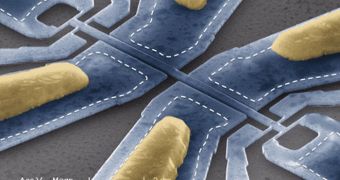Scientists have been trying to develop machines capable of weighing the mass of individual molecules for quite some time, but thus far their efforts have been fruitless. Finally, experts at the California Institute of Technology in Pasadena announce they were able to construct such an instrument.
Theirs is the first-ever mechanical device capable of measuring the mass of individual molecules, one at a time. The innovation will soon enable numerous applications in the fields of medical diagnostics, biological sciences, viral studies, nanoparticle measurements and air pollutant counts.
Using it, doctors will be able to determine the concentration of various contaminants in patients’ bloodstreams, while biologists will be able to probe the molecular machineries powering the world's most dangerous viruses.
Scientists studying nanoparticles say the device will enable them to study the small structures more precisely than possible today. Additional applications include the development of sensitive detectors, capable of measuring air pollution, or to detect biological and chemical agents in the air.
The research team is made up of experts at Caltech's Kavli Nanoscience Institute and CEA-LETI, in Grenoble, France. The group has already created a prototype of the nanoscale device. Details of how it operates appear in the August 26 issue of the top scientific journal Nature Nanotechnology.
The partnership between the Kavli Institute and CEA-LETI is called Alliance for Nanosystems VLSI.
The microscale instrument is classified as a nanoelectromechanical system (NEMS) resonator. Its main component is a tiny bridge that vibrates at a specific frequency. When a molecule lands on this cantilever, it changes the frequency by an amount consistent with its weight.
“As each particle comes in, we can measure its mass. Nobody's ever done this before,” explains the Robert M. Abbey professor of physics and applied physics, and bioengineering, Michael Roukes. He and his team have been working on this innovative technology for more than 12 years.
“The critical advance that we've made in this current work is that it now allows us to weigh molecules – one by one – as they come in,” the expert reveals. He adds that the new instrument can be included in existing measuring tools, allowing them to become even more capable.
“This result demonstrates how the Alliance for Nanosystems VLSI, initiated in 2006, creates a favorable environment to carry out innovative experiments with state-of-the-art, mass-produced devices,” comments the director of CEA-LETI,” Laurent Malier.
“These devices will enable commercial applications, thanks to cost advantage and process repeatability,” he concludes.

 14 DAY TRIAL //
14 DAY TRIAL //